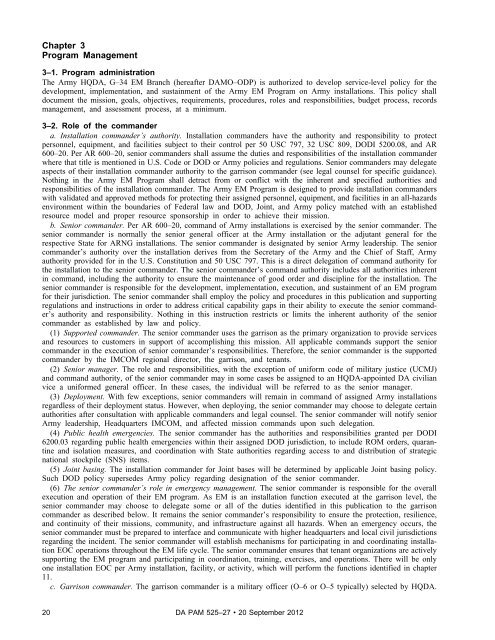Army Emergency Management Program - Federation of American ...
Army Emergency Management Program - Federation of American ...
Army Emergency Management Program - Federation of American ...
You also want an ePaper? Increase the reach of your titles
YUMPU automatically turns print PDFs into web optimized ePapers that Google loves.
Chapter 3<br />
<strong>Program</strong> <strong>Management</strong><br />
3–1. <strong>Program</strong> administration<br />
The <strong>Army</strong> HQDA, G–34 EM Branch (hereafter DAMO–ODP) is authorized to develop service-level policy for the<br />
development, implementation, and sustainment <strong>of</strong> the <strong>Army</strong> EM <strong>Program</strong> on <strong>Army</strong> installations. This policy shall<br />
document the mission, goals, objectives, requirements, procedures, roles and responsibilities, budget process, records<br />
management, and assessment process, at a minimum.<br />
3–2. Role <strong>of</strong> the commander<br />
a. Installation commander’s authority. Installation commanders have the authority and responsibility to protect<br />
personnel, equipment, and facilities subject to their control per 50 USC 797, 32 USC 809, DODI 5200.08, and AR<br />
600–20. Per AR 600–20, senior commanders shall assume the duties and responsibilities <strong>of</strong> the installation commander<br />
where that title is mentioned in U.S. Code or DOD or <strong>Army</strong> policies and regulations. Senior commanders may delegate<br />
aspects <strong>of</strong> their installation commander authority to the garrison commander (see legal counsel for specific guidance).<br />
Nothing in the <strong>Army</strong> EM <strong>Program</strong> shall detract from or conflict with the inherent and specified authorities and<br />
responsibilities <strong>of</strong> the installation commander. The <strong>Army</strong> EM <strong>Program</strong> is designed to provide installation commanders<br />
with validated and approved methods for protecting their assigned personnel, equipment, and facilities in an all-hazards<br />
environment within the boundaries <strong>of</strong> Federal law and DOD, Joint, and <strong>Army</strong> policy matched with an established<br />
resource model and proper resource sponsorship in order to achieve their mission.<br />
b. Senior commander. Per AR 600–20, command <strong>of</strong> <strong>Army</strong> installations is exercised by the senior commander. The<br />
senior commander is normally the senior general <strong>of</strong>ficer at the <strong>Army</strong> installation or the adjutant general for the<br />
respective State for ARNG installations. The senior commander is designated by senior <strong>Army</strong> leadership. The senior<br />
commander’s authority over the installation derives from the Secretary <strong>of</strong> the <strong>Army</strong> and the Chief <strong>of</strong> Staff, <strong>Army</strong><br />
authority provided for in the U.S. Constitution and 50 USC 797. This is a direct delegation <strong>of</strong> command authority for<br />
the installation to the senior commander. The senior commander’s command authority includes all authorities inherent<br />
in command, including the authority to ensure the maintenance <strong>of</strong> good order and discipline for the installation. The<br />
senior commander is responsible for the development, implementation, execution, and sustainment <strong>of</strong> an EM program<br />
for their jurisdiction. The senior commander shall employ the policy and procedures in this publication and supporting<br />
regulations and instructions in order to address critical capability gaps in their ability to execute the senior commander’s<br />
authority and responsibility. Nothing in this instruction restricts or limits the inherent authority <strong>of</strong> the senior<br />
commander as established by law and policy.<br />
(1) Supported commander. The senior commander uses the garrison as the primary organization to provide services<br />
and resources to customers in support <strong>of</strong> accomplishing this mission. All applicable commands support the senior<br />
commander in the execution <strong>of</strong> senior commander’s responsibilities. Therefore, the senior commander is the supported<br />
commander by the IMCOM regional director, the garrison, and tenants.<br />
(2) Senior manager. The role and responsibilities, with the exception <strong>of</strong> uniform code <strong>of</strong> military justice (UCMJ)<br />
and command authority, <strong>of</strong> the senior commander may in some cases be assigned to an HQDA-appointed DA civilian<br />
vice a uniformed general <strong>of</strong>ficer. In these cases, the individual will be referred to as the senior manager.<br />
(3) Deployment. With few exceptions, senior commanders will remain in command <strong>of</strong> assigned <strong>Army</strong> installations<br />
regardless <strong>of</strong> their deployment status. However, when deploying, the senior commander may choose to delegate certain<br />
authorities after consultation with applicable commanders and legal counsel. The senior commander will notify senior<br />
<strong>Army</strong> leadership, Headquarters IMCOM, and affected mission commands upon such delegation.<br />
(4) Public health emergencies. The senior commander has the authorities and responsibilities granted per DODI<br />
6200.03 regarding public health emergencies within their assigned DOD jurisdiction, to include ROM orders, quarantine<br />
and isolation measures, and coordination with State authorities regarding access to and distribution <strong>of</strong> strategic<br />
national stockpile (SNS) items.<br />
(5) Joint basing. The installation commander for Joint bases will be determined by applicable Joint basing policy.<br />
Such DOD policy supersedes <strong>Army</strong> policy regarding designation <strong>of</strong> the senior commander.<br />
(6) The senior commander’s role in emergency management. The senior commander is responsible for the overall<br />
execution and operation <strong>of</strong> their EM program. As EM is an installation function executed at the garrison level, the<br />
senior commander may choose to delegate some or all <strong>of</strong> the duties identified in this publication to the garrison<br />
commander as described below. It remains the senior commander’s responsibility to ensure the protection, resilience,<br />
and continuity <strong>of</strong> their missions, community, and infrastructure against all hazards. When an emergency occurs, the<br />
senior commander must be prepared to interface and communicate with higher headquarters and local civil jurisdictions<br />
regarding the incident. The senior commander will establish mechanisms for participating in and coordinating installation<br />
EOC operations throughout the EM life cycle. The senior commander ensures that tenant organizations are actively<br />
supporting the EM program and participating in coordination, training, exercises, and operations. There will be only<br />
one installation EOC per <strong>Army</strong> installation, facility, or activity, which will perform the functions identified in chapter<br />
11.<br />
c. Garrison commander. The garrison commander is a military <strong>of</strong>ficer (O–6 or O–5 typically) selected by HQDA.<br />
20 DA PAM 525–27 20 September 2012
















